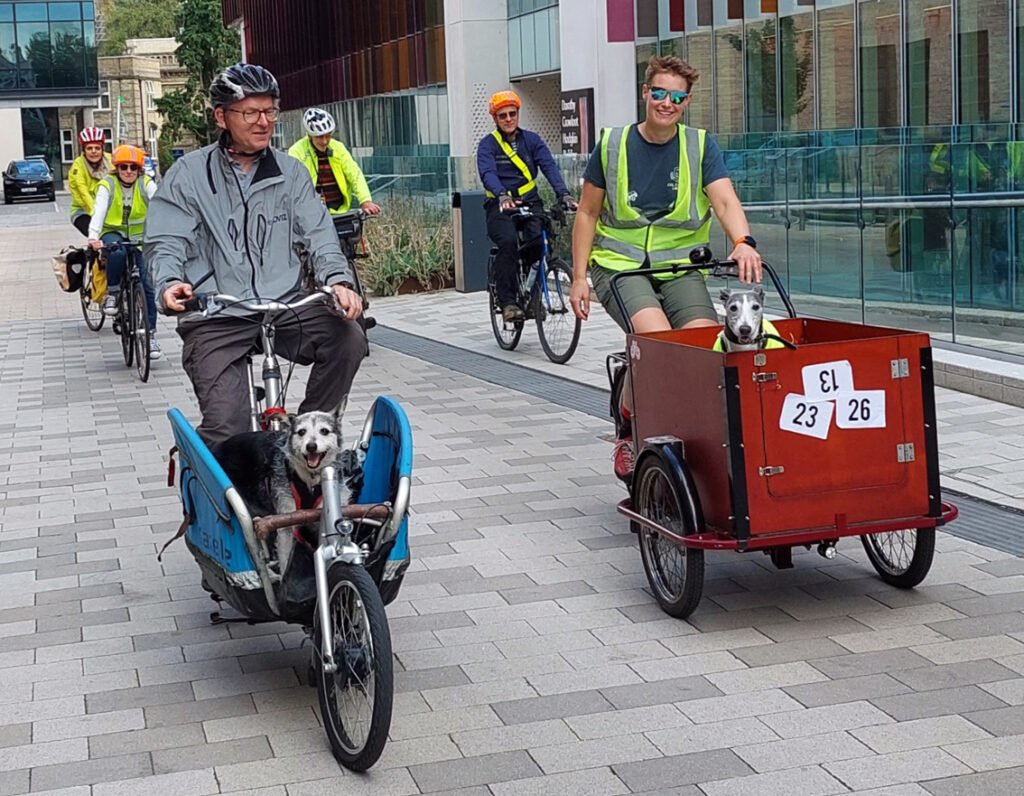Cycling with pets

By Emily Kerr
Emily is Oxford City Councillor for the Green Party, St Mary’s Ward
I heard from a resident recently who was keen to get back on her bike and wanted to take her elderly dog with her. But when she started looking at the options, she felt overwhelmed by the choices available. Could I help?
There are a number of ways to get around with your pet, and I outline some of them below.
Large dogs
If you’ve got a large dog, you’ll need a cargo bike or a trailer. Cargo bikes are more expensive and take up more space, but have the advantage that the dog rides in front of you. Many cargo-bike makers do specialist dog bikes, and your key choice is “two wheels” (faster, more nimble) or “three wheels” (more stable for slower cycling). Pedal & Post rent cargo bikes to try, or you can do a test ride at bike shops. A trailer is a cheaper option: again there are specialist dog trailers but you can just buy a child trailer second hand and use that. It’s common to put dogs and kids in the same trailer together.
With a smaller dog, or even a cat, you’ve also got the option of riding with it in the basket at the front, or a basket/carrier on the back. Tricycles can be good for this, as the dog can fit in the space between the back two wheels. If you’re using a front basket, you need to make sure your dog is secured to stop them jumping out, pet carriers should come with their own clips but you can also use a carabiner. Use a harness, not a collar, as it provides more stability and prevents neck injuries.
Travis’ two key points
Travis, who has a huge social media following due to his cycle rides with his Norwegian Forest cat Sigrid, says there are two key things to bear in mind about riding with a pet.
“You need to make sure that you’re a confident rider on the bike first – so if you buy a new bike specially for your pet, take the bike out a few times without your pet in it. But I think the most important thing is to make sure your pet has the personality and inclination to enjoy riding. Sigi didn’t try the bike until she was 3 years old but she’d been out and about with us in her harness since she was a kitten, and she’s a very adventurous cat. Our other cat used to occasionally ride in the basket but now she’s older she likes to stay at home.”
Anna’s whippet
Anna Railton, Labour’s Cabinet member for Climate Change on the City Council, takes her whippet Arthur for regular rides in her cargo trike which she bought third-hand on eBay.
“We decided on a trike because it needed high sides (he is a tall dog) and we didn’t think he would enjoy the floor tilting when going round corners. We mostly use it for taking Arthur to new places for walks though it’s come in handy for trips to the vets too. Whippets can be quite nervous dogs so we made sure we introduced Arthur gently, putting him in it while stationary, then building up the distance slowly.”

What’s sure is that pets of all shapes and sizes love the wind in their fur and riding with their owners
Other recommendations from experienced pet riders include:
- introducing your pet gradually
- bringing supplies (water, treats)
- making the carrier comfortable (e.g. with blankets)
- making sure you’ve checked the weight limit
Ultimately your choice depends on budget and what’s right for your pet. But what’s sure is that pets of all shapes and sizes love the wind in their fur and riding with their owners.
Image credits
Main photo: Emily Kerr
Men with pets: Robin Tucker
